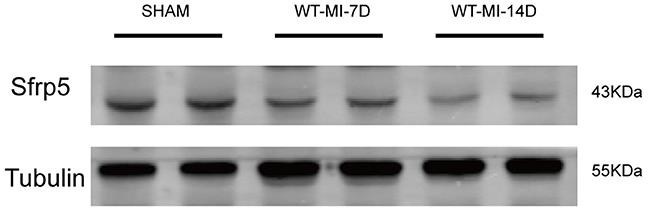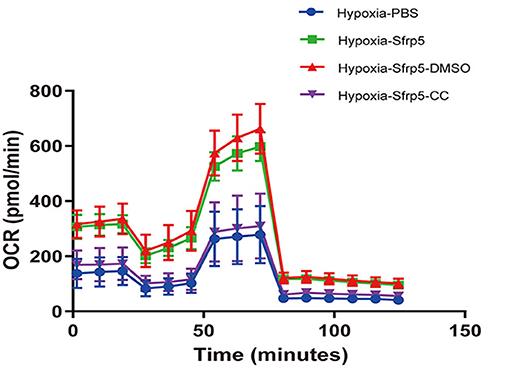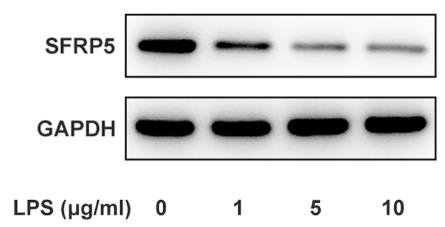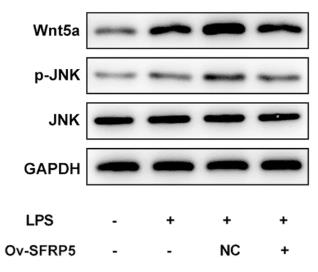SFRP5
-
Official Full Name
secreted frizzled-related protein 5 -
Overview
Secreted frizzled-related protein 5 (SFRP5) is a member of the SFRP family that contains a cysteine-rich domain homologous to the putative Wnt-binding site of Frizzled proteins. SFRPs act as soluble modulators of Wnt signaling. SFRP5 and SFRP1 may be involved in determining the polarity of photoreceptor cells in the retina. SFRP5 is highly expressed in the retinal pigment epithelium, and moderately expressed in the pancreas. [provided by RefSeq, Jul 2008] -
Synonyms
SFRP5;secreted frizzled-related protein 5;SARP3;FRP-1b;SARP-3;sFRP-5;frizzled-related protein 1b;secreted apoptosis related protein 3;secreted apoptosis-related protein 3
Recombinant Proteins
- Human
- Mouse
- Rat
- Zebrafish
- E.coli
- CHO
- Mammalian Cells
- HEK293
- His
- HA
- Flag
- SUMO
- Avi
- Fc
| Cat.# | Product name | Source (Host) | Species | Tag | Protein Length | Price |
|---|---|---|---|---|---|---|
| SFRP5-2619H | Recombinant Human SFRP5, His-tagged | E.coli | Human | His | 1-317aa | |
| Sfrp5-712M |
Active Recombinant Mouse Sfrp5 Protein, HA-tagged
|
CHO | Mouse | HA | Ala22-His314 |
|
| SFRP5-15012M | Recombinant Mouse SFRP5 Protein | Mammalian Cells | Mouse | His |
|
|
| SFRP5-254H | Recombinant Human SFRP5 protein, FLAG-tagged | HEK293 | Human | Flag | 1-317 a.a. |
|
| SFRP5-2620H | Recombinant Human SFRP5 protein, His-tagged | E.coli | Human | His | 30-317aa |
|
| Sfrp5-8102M | Recombinant Mouse Sfrp5 protein, His-tagged | E.coli | Mouse | His | Pro48~Ala161 |
|
| Sfrp5-8103R | Recombinant Rat Sfrp5 protein, His-tagged | E.coli | Rat | His | Ser45~Val162 |
|
| SFRP5-9363Z | Recombinant Zebrafish SFRP5 | Mammalian Cells | Zebrafish | His |
|
|
| SFRP5-1226H | Recombinant Human SFRP5 Protein, His&SUMO-tagged | E.coli | Human | His&SUMO | Glu30-His317 |
|
| SFRP5-2621H | Active Recombinant Human SFRP5 Protein, HA-tagged | CHO | Human | HA | 30-317 a.a. |
|
| Sfrp5-3487M | Recombinant Mouse Sfrp5 protein, His-tagged | E.coli | Mouse | His | 22-314aa |
|
| SFRP5-8086M | Recombinant Mouse SFRP5 Protein, His (Fc)-Avi-tagged | HEK293 | Mouse | Avi&Fc&His |
|
|
| SFRP5-8086M-B | Recombinant Mouse SFRP5 Protein Pre-coupled Magnetic Beads | HEK293 | Mouse |
|
Background
What is SFRP5 Protein?
SFRP5, known as secreted frizzled-related protein 5, is one of those proteins that can act as a blocker in the cell signaling world. It has this unique cysteine-rich domain that's somewhat like the Wnt-binding site, allowing it to latch onto Wnt proteins and put the brakes on their signals. This matters because Wnt signaling touches on key cell functions, like how cells grow and move. Beyond that, SFRP5 is getting attention in the metabolism arena, where it seems to play a role in managing inflammation and insulin resistance in fat tissues. This has led to ideas about using SFRP5 in treatments for metabolic disorders, given its influence on fat cell behavior and energy use.
What is the Function of SFRP5 Protein?
SFRP5 is like a regulator protein that interacts with Wnt proteins to tweak the way cells grow and move. By jamming up the Wnt signaling, it helps keep inflammation in check and is involved in managing insulin resistance. Think of it as a watchdog in our fat tissue, ensuring everything runs smoothly by controlling how fat cells grow and how our body stacks away energy. In doing so, it plays a part in looking after our metabolic health. Plus, it's been hinted that SFRP5 might be good for the heart as it offers some protective benefits, making it a possible target for therapies dealing with heart and metabolic conditions. Overall, this protein is key for keeping our body's metabolism in line and could be pretty important for treating related health issues.
SFRP5 Related Signaling Pathway
SFRP5 is this interesting protein that plays a big role in controlling the Wnt signaling pathway—think of it like a major cellular communication network influencing how cells grow and deal with inflammation. Picture SFRP5 as a sort of traffic controller, keeping Wnt proteins from going haywire by blocking their receptors, which is super important for maintaining cellular harmony and warding off things like heart disease. This protein also partners up with Wnt5a to reduce JNK signaling, which is notorious for driving inflammation. So, essentially, SFRP5 is like a peacekeeper in our body, ensuring everything functions smoothly and battling inflammation, which makes it a hot prospect for tackling diseases where the Wnt pathway goes rogue.

Fig1. Summary of Sfrp5 effects and the proposed mechanism of Sfrp5 effect on MI and mitochondrial dysfunction. (Xin Huang, 2021)
SFRP5 Related Diseases
SFRP5 is getting a lot of buzz now because it's tied to issues with metabolism and heart health. This protein is known for keeping inflammation in check and battling insulin resistance, which are big players in problems like obesity, type 2 diabetes, and metabolic syndrome. Plus, it might help out in heart disease by calming down overactive pathways that can cause trouble. There's also some suggestion that SFRP5 offers some protection to the liver, especially with non-alcoholic fatty liver disease. All in all, SFRP5 is emerging as an important player in managing some of the big health problems we're dealing with today.
Bioapplications of SFRP5
Recombinant SFRP5 protein is making waves beyond medical research, finding its way into various fields like biotechnology and industrial production. SFRP5 is like a secret weapon in science labs for exploring how cells talk to each other and grow, shedding light on diseases tied to metabolism and heart health. Industries are also digging into its promise, eyeing new treatments or diagnostic gadgets since it helps manage inflammation and insulin resistance. By understanding and utilizing SFRP5, scientists and companies are hoping to innovate solutions for some of today's prevalent health challenges, while also potentially enhancing production methods in related biotechnological applications. In essence, SFRP5's importance is expanding as it's leveraged for both health and industrial advancements.
Case Study
Case Study 1: Xin Huang, 2021
Secreted frizzled-related protein 5, or Sfrp5, seems to offer some protection in coronary heart disease, although its involvement with ischemic injury wasn't fully understood. Our study delved into how Sfrp5 affects the heart after a myocardial infarction (MI). We noticed that Sfrp5 levels dropped in the heart tissue of MI-affected mice over time. To investigate further, we used a specific virus type, AAV9, to boost Sfrp5 within cardiac tissue. This boost led to smaller infarct sizes, lower mortality from cardiac rupture, enhanced heart function, increased mitochondrial biogenesis, reduced cell death in heart cells, and less inflammation and stress in the system. Two weeks after MI, markers showed improved heart function. On a molecular scale, Sfrp5 increased certain protein expressions related to energy regulation and balanced mitochondrial dynamics, reducing damage. When testing on rat heart cells, Sfrp5 treatment lessened mitochondrial issues caused by low oxygen, but this effect depended on AMPK activity, as blocking it with compound C stopped the benefits.

Fig1. Protein expression of Sfrp5 in mouse hearts at 7 and 14 days after MI.

Fig2. Representative images of OCR in Sfrp5-treated, PBS-treated, Sfrp5+Compound C-treated and Sfrp5+DMSO-treated neonatal rat cardiac myocyte cells analyzed by the Seahorse XF.
Case Study 2: Minghui Sun, 2021
SFRP5 acts like a built-in defense against inflammation by blocking Wnt5a. This research basically explored if SFRP5 can shield cartilage cells, known as chondrocytes, from getting inflamed or dying when they come into contact with LPS, a bacterial toxin. When they pumped up SFRP5 levels in ATDC5 cells, which typically form cartilage, and then exposed these cells to LPS, the results were pretty promising. Overexpressing SFRP5 helped cut down on inflammatory markers like TNF-α, IL-1β, IL-6 and reactive oxygen species (ROS), as well as reduce signs of cell death, keeping levels of protective protein Bcl-2 up while lowering harmful ones like Bax and cleaved caspase 3. It also toned down Wnt5a and its partner JNK that otherwise get activated. On the flip side, when they cranked up Wnt5a, it kind of lessened the protective punch of SFRP5 against inflammation and cell death, bringing back some of the JNK activity.

Fig3. SFRP5 is downregulated upon LPS stimulation in ATDC5 cells.

Fig4. Overexpression of SFRP5 represses Wnt5a expression and phosphorylation of JNK.
Quality Guarantee
High Purity
.jpg)
Fig1. SDS-PAGE (Sfrp5-8103R)
Involved Pathway
SFRP5 involved in several pathways and played different roles in them. We selected most pathways SFRP5 participated on our site, such as Wnt signaling pathway, which may be useful for your reference. Also, other proteins which involved in the same pathway with SFRP5 were listed below. Creative BioMart supplied nearly all the proteins listed, you can search them on our site.
| Pathway Name | Pathway Related Protein |
|---|---|
| Wnt signaling pathway | CAMK2D1,PRKCB,FZD8B,CUL1,MMP7,TCF7L2,TBL1XR1,CHD8,PRKACBA,NKD1 |
Protein Function
SFRP5 has several biochemical functions, for example, contributes_to ATP binding,contributes_to ATPase activity,ATPase activity, coupled to transmembrane movement of substances. Some of the functions are cooperated with other proteins, some of the functions could acted by SFRP5 itself. We selected most functions SFRP5 had, and list some proteins which have the same functions with SFRP5. You can find most of the proteins on our site.
| Function | Related Protein |
|---|---|
| contributes_to ATP binding | MSH6,ATP5D,ATP1B1,MSH2,ATP1A2,ABCG8 |
| ATPase activity, coupled to transmembrane movement of substances | ABCG2,ABCA7,ABCD3B,ABCB8,ABCA9,ABCC2,Abca2,ABCD3A,ABCG3,ABCC6 |
| protein binding | TDRD7,DDAH2,JAK1,KXD1,BNIP2,ABCG2,PRMT1,LAT2,FOXK2,TWF2 |
| protein heterodimerization activity | HIST1H2BB,HIST1H4C,IKZF4,NEUROD2,TXLNG,HEXB,XBP1,H2AFY,MTTP,HIST1H2AI |
| contributes_to ATPase activity | ATP1B1,ATP5H,ATP5F1,ATP5J,ATP5D,MSH2,ATP5E,RFC3,ATP5I,ATP5A1 |
| contributes_to cholesterol transporter activity | ABCG5,APOA1,ABCG8,APOA2 |
Interacting Protein
SFRP5 has direct interactions with proteins and molecules. Those interactions were detected by several methods such as yeast two hybrid, co-IP, pull-down and so on. We selected proteins and molecules interacted with SFRP5 here. Most of them are supplied by our site. Hope this information will be useful for your research of SFRP5.
Resources
Related Services
Related Products
References
- Kikuchi, R; Nakamura, K; et al. An antiangiogenic isoform of VEGF-A contributes to impaired vascularization in peripheral artery disease. NATURE MEDICINE 20:1464-1471(2014).
- You, JJ; Wen, L; et al. Expression of SFRP Family Proteins in Human Keratoconus Corneas. PLOS ONE 8:-(2013).
- Rulifson, IC; Majeti, JZ; et al. Inhibition of secreted frizzled-related protein 5 improves glucose metabolism. AMERICAN JOURNAL OF PHYSIOLOGY-ENDOCRINOLOGY AND METABOLISM 307:E1144-E1152(2014).


